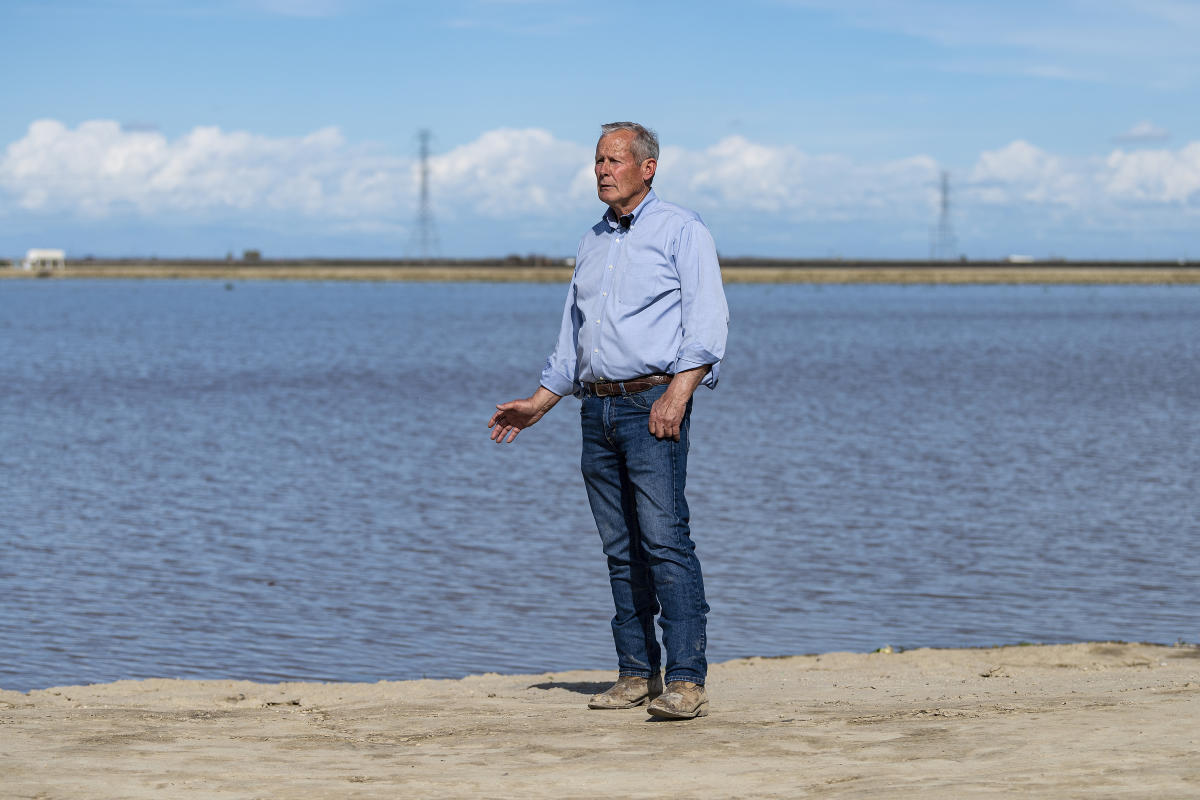A field that has long grown tomatoes, peppers and onions now looks like a windblown ocean, as farmer Don Cameron tries to absorb runoff from an erratically wet year in California to replenish the groundwater basin that is its only source to water his crops.
Taking a few tomatoes out of production for a year is an easy choice if it means increasing the future water supply for his farm, about 35 miles southwest of Fresno. It pumps 300 acre-feet a day — enough to supply hundreds of households for a year — from the Kings River’s gushing North Fork to former vegetable fields and others dotted with pistachio trees, which can withstand heavy flooding.
“We knew that in the long run we would go out of business if we didn’t have water,” Cameron said. “We’re doing our part to protect communities downstream, but we’re also putting the water in the ground.”
The 70-year-old has spent more than a decade building and expanding a system to divert floodwaters from nearby rural communities and is pioneering the practice of on-farm charging, or flooding farmland during rainy periods to help restore the groundwater basin.
But he’s not alone. State agencies, water district officials, and nonprofits view the practice as a way to weather climate swings, especially as California muddles through a winter that experts predict the snow pack in the Sierra Nevada could last for months.
Groundwater resources are essential to both farms and communities in the fertile Central Valley, an important source of food for the United States.
That’s even more true during drought years, when groundwater accounts for up to 60% of the state’s water supply, compared to 40% in non-drought conditions, said Wade Crowfoot, secretary of California’s Natural Resources Agency.
But years of drought have forced farmers to pump deeper and deeper, depleting what was left and draining wells.
Hoping to reverse that trend, water agencies have built basins in the valleys to try to catch the water in rainy years and let it seep back into the ground. Now many hope to use large tracts of farmland for a similar purpose.
Groundwater recharge projects are a “critical, important part of our future infrastructure,” Crowfoot said.
The Tulare Irrigation District, for example, has doubled the amount of water it can divert this year thanks to farmers willing to use it, says Daniel Mountjoy, director of resource stewardship at the nonprofit organization Sustainable Conservation, which is supporting the expansion of on-farm charging. supports.
“Farmland is something you can expand into when you have a crazy year like this,” he said. “They are the solution.”
The idea of using farmland to replenish groundwater has been around for years. After California enacted a law in 2014 requiring regional agencies to sustainably manage their aquifers to prevent overpumping, more farmers faced with the prospect of fallow fields began considering it.
With the potential for flooding in small towns and rural communities this season, Governor Gavin Newsom this month signed an order making it easier for farmers to direct floodwaters to their fields.
While some farmers like Cameron are ready to flood their fields now, many others are not. Still, the rain and looming pump limits have sparked interest, said Wendy Rash, a water quality specialist with the U.S. Department of Agriculture’s Natural Resources Conservation Service.
Last year, her agency started a pilot program for 20 farmers, and more than two dozen in Fresno County alone were recently in talks about joining the growing effort in its second year. If successful, the program could be replicated in other Western states.
The McMullin Area Groundwater Sustainability Agency, which operates in part of the Central Valley, has developed an on-farm-recharge university to train farmers in the field. One of them, Mark Pitman, said he has always used water sparingly, but his orange grove, which is close to a proposed canal, could eventually be flooded.
“If you don’t flood it, you may not be able to water your crop next year if it’s rough,” Pitman said. “It’s six of one, half a dozen of another.”
Some environmental groups favor on-farm reloading but urge caution over concerns that pesticides or other contaminants could be flushed into a system that is also a source of drinking water.
The concern is “you may create a groundwater quality problem when you try to solve a groundwater supply problem,” said Michael Claiborne, director-attorney at Leadership Counsel, a nonprofit organization that focuses on Valley communities.
With such concerns in mind, Newsom’s recent order renders dairy lands and fields where pesticides have recently been applied ineligible. Also, farmers must report to the state when they divert water.
It is not immediately clear how farmers will be compensated, but some say they expect water credit in the future. Not all of the water will flow back to those who participate, but experts expect they will benefit, as will their neighbours.
Some soil conditions and crops are better suited for charging than others. Grapes, for example, can withstand large amounts of water, especially in cold temperatures, and so can pecans, says Philip Bachand, an environmental engineer who worked with Cameron to charge.
In 2017, another wet year, Cameron tried to flood almonds, pistachios, walnuts and wine grapes and found they could survive as long as the water stayed cold. He said it’s hard to track where all the water went, but he measured a 40-foot rise in the water table below his flooded vineyard.
Back then, Cameron said, he moved the water with a much smaller system that he has since expanded with help from a $5 million state grant to significantly increase its charging capacity.
“We’ve got the location, we’ve got the ground.” said Cameron. “And we have the will to do it.”

